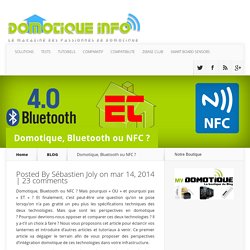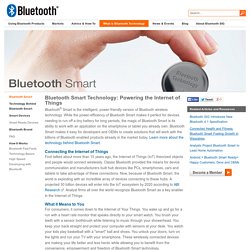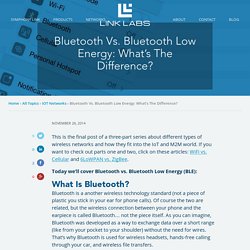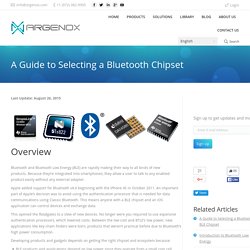

QN9021. Quality and reliability disclaimer Important Legal Notice on the product/generic quality information, No Warranty NXP Semiconductors is providing this data for your convenience only.
Please note however that NO WARRANTY, REPRESENTATION, GUARANTEE OR LEGALLY BINDING PRODUCT DESCRIPTION is provided by publishing this informational data, nor does NXP Semiconductors acknowledge or accept any liability related thereto. The documentation and data on NXP Semiconductors products can be found in the data sheets as officially published by NXP Semiconductors. For all purchase of products from NXP Semiconductors the NXP Semiconductors' General Terms and Conditions of Commercial Sale will apply. Any use of the data provided hereunder is at your own risk. Your use of this data, and all consequences of such use, is solely your responsibility. The RoHS data provided hereunder is preliminary and non binding for NXP Semiconductors.
1. Introduction - Getting Started with Bluetooth Low Energy. Bluetooth Low Energy (BLE, also marketed as Bluetooth Smart) started as part of the Bluetooth 4.0 Core Specification.

It’s tempting to present BLE as a smaller, highly optimized version of its bigger brother, classic Bluetooth, but in reality, BLE has an entirely different lineage and design goals. Originally designed by Nokia as Wibree before being adopted by the Bluetooth Special Interest Group (SIG), the authors weren’t trying to propose another overly broad wireless solution that attempts to solve every possible problem. From the beginning, the focus was to design a radio standard with the lowest possible power consumption, specifically optimized for low cost, low bandwidth, low power, and low complexity. These design goals are evident through the core specification, which attempts to make BLE a genuine low-power standard, designed to actually be implemented by silicon vendors and used in the real world on a tight energy and silicon budget.
Based on Specification Support Table 1-1.
MtM Technology Corporation. nRF51 SDK - S110 SoftDevice: Introduction. Bluetooth 4.0: An introduction to Bluetooth Low Energy-Part II. Record de sobriété pour une solution Bluetooth Smart combinant circuit radio et pile de protocoles. LairdTech. The BT800 has a tiny footprint as small as 8.5 x 13mm, yet output power at 8dBm, making these modules ideal for applications where designers need both performance and minimum size.

For maximum flexibility in systems integration, the modules are designed to support a full speed USB interface plus GPIO and additionally I2S and PCM audio interfaces. Bluetooth Development Portal. When the Bluetooth SIG announced the formal adoption of Bluetooth® Core Specification version 4.0, it included the hallmark Bluetooth Smart (low energy) feature.

This final step in the adoption process opened the door for qualification of all Bluetooth product types to version 4.0 and higher. Development Portal. BTRichHTML4 Page Image.

Domotique, Bluetooth ou NFC ? Domotique, Bluetooth ou NFC ?

Mais pourquoi « OU » et pourquoi pas « ET » ? Et finalement, c’est peut-être une question qu’on se pose lorsqu’on n’a pas gratté un peu plus les spécifications techniques des deux technologies. Mais que sont les perspectives en domotique ? Smart Devices List. Le BLE (Bluetooth Low Energy) : le protocole inattendu qui démode le NFC. Le BLE ou Bluetooth Low Energy est principalement destiné aux objets connectés pour lesquels le besoin en débit de transmission de données est faible.

Il est pour le moment utilisé principalement par Paypal et Apple, mais Androïd et Samsung commencent à se l’approprier. A l’origine il y avait le Bluetooth, un protocole de communication moribond, coincé entre le WiFi et le NFC qui, en dehors des oreillettes pour téléphone et des kits main libre pour le monde automobile, risquait fort de sombrer dans un profond oubli. L’intuition de Nokia Pourtant Nokia, le concepteur de Bluetooth, a une intuition en lançant Wibree (autre nom du BLE) : un protocole réseau de type PAN (Personnal Area Network) mais cette fois très économe en consommation électrique, au contraire du Bluetooth, qui s’était vu privé de l’accès au monde mobile à cause de ce péché originel.
Bluetooth low energy. Smart. BTRichHTML2 Bluetooth® Smart is the intelligent, power-friendly version of Bluetooth wireless technology.

While the power-efficiency of Bluetooth Smart makes it perfect for devices needing to run off a tiny battery for long periods, the magic of Bluetooth Smart is its ability to work with an application on the smartphone or tablet you already own. Bluetooth Smart makes it easy for developers and OEMs to create solutions that will work with the billions of Bluetooth enabled products already in the market today. Learn more about the technology behind Bluetooth Smart. Connecting the Internet of Things First talked about more than 15 years ago, the Internet of Things (IoT) theorized objects and people would connect wirelessly. . What it Means to You For consumers, it comes down to the Internet of Your Things. Powering New Verticals Bluetooth technology gained an early foothold in several industries like consumer electronics, PC peripherals and automotive. Bluetooth vs. Bluetooth Low Energy.
This is the final post of a three-part series about different types of wireless networks and how they fit into the IoT and M2M world.

If you want to check out parts one and two, click on these articles: WiFi vs. Cellular and 6LoWPAN vs. ZigBee. A Guide to Selecting a Bluetooth and BLE Chipset. Let’s get an overview at some of the chipsets and vendors out there: You’ll first notice that most of the devices in the table a Single Mode only, and that most of those run v4.1 of the Bluetooth Specification.

Bluetooth v4.2 hasn’t made it yet to the market completely because it requires updated hardware and because it requires support on both sides of the link. Dual Mode devices are not as popular in new applications because of cost and the complexity of supporting Bluetooth BR/EDR (Classic). Power consumption, which is often a critical factor in the decision, is always a complex question and you should look at more than just the BLE peaks. Looking at the Peak BLE current in the table above gives some information about how long the solution will last. Most of the devices are offered in two packages: QFN and WLCSP. Let’s look at the differences: